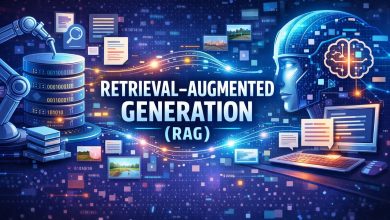
AI is no longer coming, it’s already reshaping how we work. And with the rise of agentic AI, businesses need more than ambition. They need a plan.
For business leaders, AI is a ‘now’ problem and a ‘now’ advantage.
The UK government’s AI strategy has set out a bold ambition: to make the UK a global leader in artificial intelligence. In fact, new research shows that AI is already transforming how organisations operate across sectors.
But with rapid innovation comes mounting complexity. From deployment and governance to compliance and security, decision-makers must act with speed and intent. The risk isn’t just falling behind. It’s introducing vulnerabilities into the organisation or failing to generate value.
That risk becomes even more acute as we enter the next phase of AI adoption and innovation: the agentic era.
Agentic AI in a nutshell
Agentic AI refers to artificial intelligence that can act independently to achieve defined goals. Unlike traditional, reactive AI that responds to user input or commands, agentic AI is proactive. It can assess situations, plan actions, make decisions, and execute tasks without the need for constant human direction. Rather than a generic solution, it can also be tailored to specific use cases, departments, or areas of expertise.
What’s particularly exciting is agentic AI’s potential to solve complex, multi-step problems in environments that change rapidly—all without being asked or instructed. These systems are no longer basic digital assistants. They are autonomous agents capable of making meaningful contributions to business outcomes. In other words, they’re our new teammates.
How it’s already being used
This isn’t a possibility—it’s going to happen, because agentic AI is already proving so useful across key business functions:
In HR, for example, agents can help identify skill gaps, recommend training pathways, or even automate interview scheduling. They can also assist in tracking employee wellbeing and supporting tailored development plans.
In finance, agents can flag anomalies, run real-time forecasts, and propose adjustments to meet financial targets.
In sales, AI can surface high-quality leads, personalise outreach, and autonomously manage follow-ups to maintain momentum.
In marketing, it can conduct A/B tests, recommend budget shifts, and ensure timely publishing of content. While human oversight remains essential—particularly for content generation—agents can still provide valuable performance insights and operational support.
In customer service, agents are beginning to resolve issues before they escalate, sometimes even before the customer notices. That kind of responsiveness redefines what good service looks like.
The common thread? Agentic AI systems extend the capacity of human teams without replacing them. But how do you ensure they are designed and deployed responsibly, and that they act as trusted teammates, not opaque black boxes?
As these agents become increasingly ingrained in the bedrock of business, companies are going to introduce platforms to centrally govern both human and digital workers. These systems make it possible to define the purpose, scope, and permissions of each agent from day one. It’s how you ensure AI agents are safe, auditable, aligned to business objectives, and delivering measurable results.
Why governance matters
This technology cannot be deployed in isolation. It must be governed.
As the number and sophistication of agents grow, so does the need for oversight. Agentic AI introduces new variables into enterprise environments—from data access and operational authority to ethical risk and unintended consequences. Without clear governance, these agents can become fragmented, introduce security vulnerabilities, or undermine compliance.
That’s why centralised governance is essential.
Businesses need a single source of truth for managing agent lifecycles, roles, access levels, and behaviours. This will ensure that humans remain in control and that AI is delivering value transparently.
Importantly, this approach also ensures that AI isn’t running unchecked. Governance platforms can enforce enterprise-grade controls: zero-trust access, identity verification, policy enforcement, and real-time monitoring. That level of oversight builds trust—not just internally, but with regulators and end users too.
The businesses that lead in the agentic AI era won’t just be the fastest adopters. They’ll be the most disciplined. And they’ll be the ones that embed this technology not just into their stack, but into their strategy.
A digital teammate, not a black box
The most effective users of AI view it not as a threat to human roles, but as a tool to enhance human potential. The aim isn’t to replace people—it’s to remove the repetitive, administrative, and time-consuming barriers that get in the way of creativity, insight, and progress.
Agentic AI, when embedded into trusted enterprise systems, becomes more than just a tool—it becomes a digital teammate. One that helps humans focus on what matters most while ensuring operations run smoother, smarter, and more efficiently.
It’s important to remember, this isn’t a futuristic concept. Agentic AI is already here. The question isn’t whether to use it, but how to adopt it responsibly. Leaders must treat it not as another tool, but as a new class of digital coworker.
Agentic AI will define the next chapter of enterprise technology. It’s up to today’s leaders to shape it, before it shapes them.





